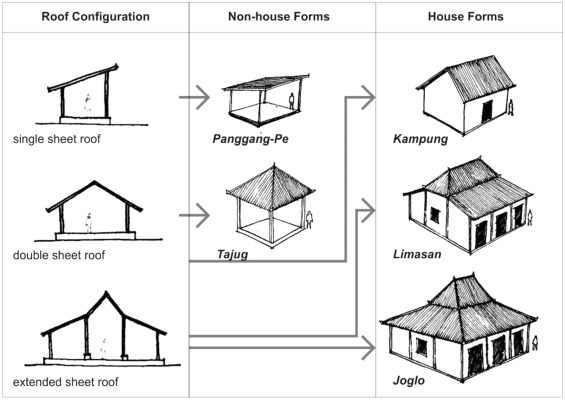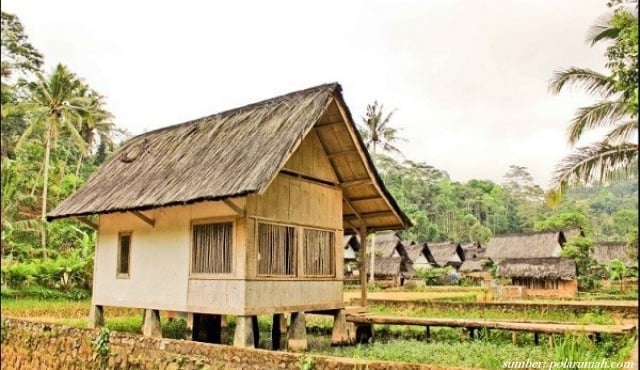
Traditional Limasan House of Trajumas Lawakan: An Architectural Overview
Indonesia is a nation renowned for its rich cultural diversity and traditional architecture, which reflects the history, values, and environment of its various regions. Among the many traditional houses, the Rumah Adat Rumah Limasan Trajumas Lawakan stands out as a distinctive example of regional architectural identity. This traditional house is primarily found in parts of Sumatra and the surrounding islands, embodying local cultural expressions through its unique structure and design. In this article, we will explore the architectural features, historical significance, structural design, cultural symbolism, functions, regional variations, preservation efforts, challenges, and the future prospects of Rumah Limasan Trajumas Lawakan, providing a comprehensive understanding of this important cultural heritage.
Architectural Features of Rumah Limasan Trajumas Lawakan
The Rumah Limasan Trajumas Lawakan is characterized by its distinctive layered roof structure, which resembles a series of overlapping pyramids or limas, hence the name "Limasan." The roof is typically steeply pitched, allowing for effective rainwater runoff in the tropical climate, and is often decorated with intricate carvings or motifs that reflect local artistic traditions. The house is usually elevated on stilts, a common feature in Indonesian traditional architecture, serving both practical purposes such as protection from flooding and pests, and symbolic ones related to social hierarchy. The walls are often made from bamboo, wood, or woven materials, providing ventilation and cooling in hot weather, while the overall design emphasizes harmony with nature.
The layout of Rumah Limasan Trajumas Lawakan is usually rectangular or square, with the main living area occupying the central space. Additional rooms or verandas may extend from the main structure, providing space for social gatherings or family activities. The entrance is typically positioned to face a specific direction, often aligned with local spiritual or cultural beliefs. Decorative elements such as carved wood panels, painted motifs, and traditional ornaments adorn the structure, reflecting the artistic heritage of the community. The combination of functional design and aesthetic embellishments makes this house a true embodiment of local craftsmanship.
The roof’s layered design not only enhances visual appeal but also serves practical purposes, such as insulation and stability. The construction techniques involve traditional methods passed down through generations, utilizing locally available materials. The use of natural, biodegradable materials aligns with sustainable practices and environmental harmony. The spatial arrangement within the Rumah Limasan Trajumas Lawakan facilitates social cohesion, with communal spaces promoting interaction among residents. Overall, its architectural features exemplify a thoughtful integration of form, function, and cultural expression.
The house’s structural elements are designed to withstand the regional climate and environmental conditions. The stilts elevate the main living areas, protecting inhabitants from seasonal flooding and pests. The steep roof pitch minimizes the accumulation of debris and allows for quick water runoff during heavy rains. The materials used, such as bamboo and wood, are chosen for their availability and durability, ensuring longevity when properly maintained. This architecture reflects a deep understanding of local ecology and building practices, making Rumah Limasan Trajumas Lawakan a resilient and culturally significant structure.
In addition to its functional aspects, the architectural features of Rumah Limasan Trajumas Lawakan serve symbolic purposes. The layered roof symbolizes social hierarchy or spiritual beliefs, while the decorative carvings often depict mythological stories or ancestral symbols. The overall design emphasizes balance, harmony, and a connection to the natural environment, core principles in many indigenous Indonesian cultures. This integration of aesthetics and symbolism elevates the house beyond mere shelter, making it a cultural artifact that embodies community values and identity.
Historical Significance of Rumah Limasan in Local Culture
The Rumah Limasan Trajumas Lawakan holds a significant place in the history of the local communities where it is found. Traditionally, these houses served not only as residences but also as symbols of social status and cultural identity. The intricate craftsmanship and architectural complexity indicated the social standing of the family or clan residing within. Over generations, Rumah Limasan became a tangible expression of local heritage, embodying the community’s history, beliefs, and traditional practices.
Historically, the construction of Rumah Limasan was a communal activity, involving skilled artisans and craftsmen who passed down techniques and motifs through oral traditions and apprenticeships. These houses often hosted important cultural ceremonies, rituals, and gatherings, making them centers of social life. Their design reflected local cosmology, with specific orientations, symbolic carvings, and spatial arrangements aligned with spiritual beliefs. As such, Rumah Limasan served as cultural anchors, preserving indigenous knowledge and artistic expression.
Throughout history, the architecture of Rumah Limasan Trajumas Lawakan has evolved in response to changing social and environmental conditions. External influences, such as trade and interaction with other cultures, introduced new motifs or construction methods, yet core elements remained intact. Colonial periods and modern developments posed threats to traditional designs, but the houses persisted as symbols of resilience and cultural continuity. Today, they are regarded as invaluable cultural assets, representing the historical narrative of the local communities.
The significance of Rumah Limasan extends beyond its physical form; it embodies the community’s collective memory and cultural values. Many houses have been designated as heritage sites or cultural landmarks, highlighting their importance in local history. Preservation of these structures helps maintain a tangible link to the past, fostering pride and identity among younger generations. The Rumah Limasan Trajumas Lawakan thus remains a living testament to the history, artistry, and social fabric of its people.
In the broader context of Indonesian history, Rumah Limasan exemplifies the diversity of traditional architecture that varies across regions. It reflects regional adaptations to climate, environment, and social organization, contributing to Indonesia’s rich architectural mosaic. The house’s historical significance is also recognized in efforts to document and promote indigenous building techniques, ensuring that this cultural heritage endures amid modernization. As a symbol of cultural resilience, Rumah Limasan continues to inspire preservation efforts and cultural revival initiatives.
The historical importance of Rumah Limasan Trajumas Lawakan lies in its role as a vessel of cultural transmission. It captures stories of ancestral life, community values, and artistic expression, serving as a living museum of local tradition. Through its enduring presence, it reminds contemporary society of the importance of safeguarding cultural diversity and respecting indigenous architectural practices. The house stands as a testament to the enduring spirit of the community, bridging past and present through its enduring legacy.
Structural Design and Materials Used in Rumah Limasan
The structural design of Rumah Limasan Trajumas Lawakan is a testament to traditional Indonesian ingenuity, combining practicality with cultural symbolism. The house is primarily constructed with a framework of wooden or bamboo poles, which form the main support system. These vertical posts are anchored into the ground or onto stilts, providing stability and elevating the house above ground level. The layered, pyramid-shaped roof is constructed using similar materials, with each layer reinforced by wooden battens or rafters that support the roof covering. The design ensures durability, flexibility, and resilience against environmental elements.
Materials used in building Rumah Limasan are predominantly locally sourced, emphasizing sustainability and environmental harmony. Bamboo, known for its strength and rapid growth, is a common choice for walls, flooring, and decorative elements. Wooden planks or logs are used for structural supports, doors, and window frames. The roof is typically covered with thatch made from dried palm leaves, reeds, or alang-alang grass, which provide excellent insulation and water resistance. These materials are lightweight yet sturdy, allowing for ease of construction and repair while maintaining the house’s integrity.
The construction process involves traditional techniques passed down through generations, such as joinery methods without nails or metal fasteners. Instead, wooden pegs, ropes, and intricate carving joints secure the structure. This craftsmanship ensures that the house remains flexible enough to withstand earthquakes or strong winds, a crucial consideration in many Indonesian regions. The elevated stilts not only protect against floods but also promote airflow beneath the house, reducing humidity and preventing rot. These design features collectively contribute to a resilient and sustainable architectural form.
The interior layout of Rumah Limasan typically includes a main living space, sometimes divided into specific zones for sleeping, cooking, and social activities. The materials used inside are also natural, such as woven mats, bamboo partitions, and handcrafted furniture. The open-plan design facilitates ventilation and natural lighting, essential in tropical climates. The use of traditional materials and construction techniques emphasizes a harmonious relationship with the environment, ensuring that the house remains functional and comfortable over time.
The structural design also incorporates symbolic elements, such as carvings and motifs that adorn the beams, doors, and walls. These decorative features often depict mythological figures, ancestral symbols, or natural motifs, reinforcing cultural beliefs and social values. The layered roof, with its intricate joinery and ornamentation, serves as a visual representation of social hierarchy or spiritual beliefs. Overall, the structural design and materials of Rumah Limasan Trajumas Lawakan embody a sustainable, culturally rich approach to traditional architecture.
Maintenance and repair of Rumah Limasan require an understanding of these traditional construction techniques and materials. Regular upkeep of the bamboo and thatch roof, along with the replacement of worn-out components, ensures longevity. Preservation efforts often involve training local artisans in traditional craftsmanship to sustain these skills. The combination of thoughtful design, natural materials, and cultural symbolism makes Rumah Limasan not just a dwelling but a living piece of cultural heritage that continues to inspire sustainable building practices.
Cultural Symbolism Embedded in Rumah Limasan Trajumas Lawakan
The Rumah Limasan Trajumas Lawakan is more than a physical structure; it is a profound symbol imbued with cultural and spiritual meaning. The layered, pyramid-like roof design symbolizes the hierarchical universe or spiritual ascent, representing the connection between the earthly realm and the spiritual world. This architectural element is often associated with local cosmology, where the house acts as a microcosm of the universe, reflecting the community’s beliefs about harmony, balance, and spiritual protection.
Decorative carvings and motifs found throughout the Rumah Limasan carry deep symbolic significance. These embellishments often depict myth



